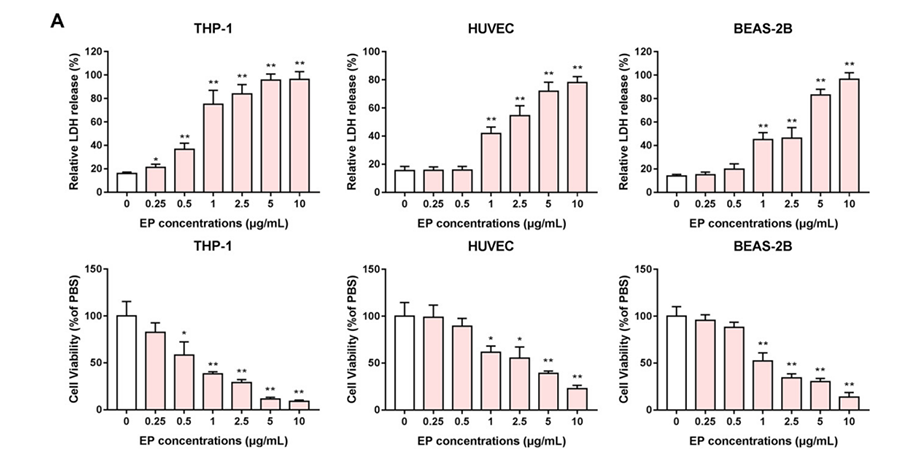Necrosulfonamide |
| カタログ番号GC10150 |
ネクロスルフォンアミド(NSA)は、MLKL(mixed lineage kinase domain-like protein)の特異的な阻害剤です。[1]
Products are for research use only. Not for human use. We do not sell to patients.

Cas No.: 1360614-48-7
Sample solution is provided at 25 µL, 10mM.
Necrosulfonamide (NSA) is a specific inhibitor of MLKL (mixed lineage kinase domain-like protein)[1]. Necrosulfonamide, an inhibitor of GSDMD, could inhibit PPVI-induced activation of the NLRP3 inflammasome[2].
In vitro efficacy test it shown that IC50 values for Necrosulfonamide determined in cell-based necroptosis (NEC), apoptosis (APOP), or toxicity (TOX) assays in Jurkat and U937 cells were 1399 nM, 6197 nM, 454 nM, >100,000 nM and 14694 nM, respectively[3]. In vitro, treatment with 10 µM or 20 µM Necrosulfonamide inhibited GSDMD-mediated IL-1β release after inflammasome stimulation, demonstrating complete suppression of IL-1β even 60 min after stimulation in cells stimulated with LPS and nigericin[4].
In vivo, male adult C57BL/6 mice were administrated 5 mg/kg Necrosulfonamide intraperitoneally twice a day significantly reduced the hematoma size, suppressed inflammatory cells and cytokines and protected the blood-brain barrier compared to vehicle controls[1]. In vivo, rats were injected with Necrosulfonamide (10 mg/kg) reduced the levels of NOD-like receptor 3 (NLRP3), GSDMD-N, phosphorylated-MLKL, and phosphorylated-RIP3 levels in cardiac tissue with corresponding reductions in inflammatory cytokine levels[5]. In vivo, mice were injected 1, 5, or 10 mg/kg Necrosulfonamide intraperitoneally improved the motor function and spinal edema of SCI-Mice with a therapeutic window[6]. In vivo, rats were administrated with 0.5 mg/body Necrosulfonamide intraperitoneally protected lung IRI through the inhibition of necroptosis[7]. Mice were treated with NSA (0.5 mg/kg/day for 3 days and 1 mg/kg/day for 7 days, every second day of i.p. injection) restorted motor performance defects, striatal TH + fiber deficiency, and TH + cell loss in a mouse model of PD[8]. In vivo, rats were administrated with 1.65 mg/kg/day Necrosulfonamide intraperitoneally for 6 weeks obviously amended AlCl3-induced spatial learning and memory deficits, as demonstrated by enhanced rat performance in Morris water and Y-mazes[9].
References:
[1] Zhang X, et al. Necrosulfonamide Alleviates Acute Brain Injury of Intracerebral Hemorrhage via Inhibiting Inflammation and Necroptosis. Front Mol Neurosci. 2022 Jun 2;15:916249.
[2] Teng JF, et al. Polyphyllin VI Induces Caspase-1-Mediated Pyroptosis via the Induction of ROS/NF-κB/NLRP3/GSDMD Signal Axis in Non-Small Cell Lung Cancer. Cancers (Basel). 2020 Jan 13;12(1):193.
[3] RÜbbelke M, et al. Locking mixed-lineage kinase domain-like protein in its auto-inhibited state prevents necroptosis. Proc Natl Acad Sci U S A. 2020 Dec 29;117(52):33272-33281.
[4] Rathkey JK, et al. Chemical disruption of the pyroptotic pore-forming protein gasdermin D inhibits inflammatory cell death and sepsis. Sci Immunol. 2018 Aug 24;3(26):eaat2738.
[5] He F, et al. Necrosulfonamide improves post-resuscitation myocardial dysfunction via inhibiting pyroptosis and necroptosis in a rat model of cardiac arrest. Eur J Pharmacol. 2022 Jul 5;926:175037.
[6] Jiao J, et al. Necrosulfonamide Ameliorates Neurological Impairment in Spinal Cord Injury by Improving Antioxidative Capacity. Front Pharmacol. 2020 Jan 9;10:1538.
[7] Ueda S, et al. Protective effect of necrosulfonamide on rat pulmonary ischemia-reperfusion injury via inhibition of necroptosis. J Thorac Cardiovasc Surg. 2022 Feb;163(2):e113-e122.
[8] Leem YH, et al. Necrosulfonamide exerts neuroprotective effect by inhibiting necroptosis, neuroinflammation, and α-synuclein oligomerization in a subacute MPTP mouse model of Parkinson's disease. Sci Rep. 2023 May 31;13(1):8783.
[9] Motawi TMK, et al. Ameliorative Effect of Necrosulfonamide in a Rat Model of Alzheimer's Disease: Targeting Mixed Lineage Kinase Domain-like Protein-Mediated Necroptosis. ACS Chem Neurosci. 2020 Oct 21;11(20):3386-3397.
Average Rating: 5 (Based on Reviews and 23 reference(s) in Google Scholar.)
GLPBIO products are for RESEARCH USE ONLY. Please make sure your review or question is research based.
Required fields are marked with *






